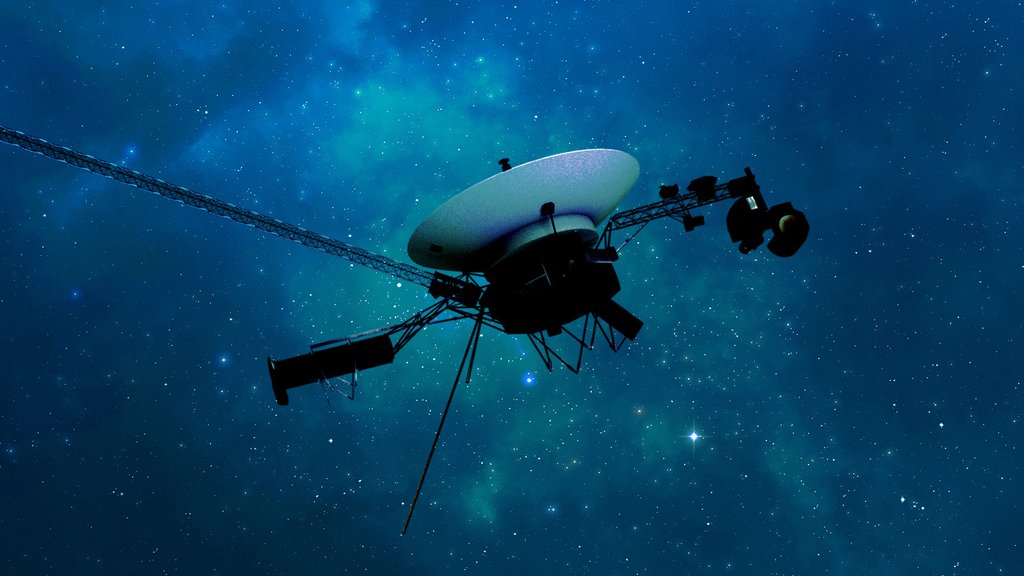
NASA’s Voyager 1 spacecraft is depicted in this artist’s concept traveling through interstellar space, or the space between stars, which it entered in 2012.
After some inventive sleuthing, the mission team can — for the first time in five months — check the health and status of the most distant human-made object in existence.
For the first time since November, NASA’s Voyager 1 spacecraft is returning usable data about the health and status of its onboard engineering systems. The next step is to enable the spacecraft to begin returning science data again. The probe and its twin, Voyager 2, are the only spacecraft to ever fly in interstellar space (the space between stars).
Voyager 1 stopped sending readable science and engineering data back to Earth on Nov. 14, 2023, even though mission controllers could tell the spacecraft was still receiving their commands and otherwise operating normally. In March, the Voyager engineering team at NASA’s Jet Propulsion Laboratory in Southern California confirmed that the issue was tied to one of the spacecraft’s three onboard computers, called the flight data subsystem (FDS). The FDS is responsible for packaging the science and engineering data before it’s sent to Earth.

After receiving data about the health and status of Voyager 1 for the first time in five months, members of the Voyager flight team celebrate in a conference room at NASA’s Jet Propulsion Laboratory on April 20.
The team discovered that a single chip responsible for storing a portion of the FDS memory — including some of the FDS computer’s software code — isn’t working. The loss of that code rendered the science and engineering data unusable. Unable to repair the chip, the team decided to place the affected code elsewhere in the FDS memory. But no single location is large enough to hold the section of code in its entirety.
So they devised a plan to divide the affected code into sections and store those sections in different places in the FDS. To make this plan work, they also needed to adjust those code sections to ensure, for example, that they all still function as a whole. Any references to the location of that code in other parts of the FDS memory needed to be updated as well.
The team started by singling out the code responsible for packaging the spacecraft’s engineering data. They sent it to its new location in the FDS memory on April 18. A radio signal takes about 22 ½ hours to reach Voyager 1, which is over 15 billion miles (24 billion kilometers) from Earth, and another 22 ½ hours for a signal to come back to Earth. When the mission flight team heard back from the spacecraft on April 20, they saw that the modification worked: For the first time in five months, they have been able to check the health and status of the spacecraft.
During the coming weeks, the team will relocate and adjust the other affected portions of the FDS software. These include the portions that will start returning science data.Voyager 2 continues to operate normally. Launched over 46 years ago, the twin Voyager spacecraft are the longest-running and most distant spacecraft in history. Before the start of their interstellar exploration, both probes flew by Saturn and Jupiter, and Voyager 2 flew by Uranus and Neptune.
News
Elon Musk Makes Headlines with Bold Call to Ban ‘The View’: “Why Does Musk Want ‘The View’ Off the Air? Sparks Debate Over TV Preferences”
‘The View,’ a famous daytime talk programme, has Elon Musk’s strong displeasure, an audacious statement that has created debates nationwide. Taking to social media to air his grievances, the software mogul—who is notoriously forthright and unafraid of controversy—said that he…
Breaking: Dennis Quaid Joins Roseanne Barr and Tim Allen in New Non-Woke Actors’ Alliance
In an era where the entertainment industry is frequently polarized by social and political ideologies, a new alliance is making headlines. Veteran actors Roseanne Barr and Tim Allen have launched a “Non-Woke Actors’ Alliance,” and their latest addition, Dennis Quaid,…
Breaking: Caitlin Clark Secures Place in 2024 Olympics Amid Brittney Griner’s Disqualification – What Does This Mean for Team USA?
In a dramatic turn of events in the world of basketball, Caitlin Clark has qualified for the U.S. women’s basketball team for the 2024 Olympics, while Britney Griner, one of the sport’s most iconic players, has been disqualified. This unexpected…
Breaking: CBS Offers Tim Allen and Richard Karn $1 Billion for Non-Woke Sitcom “Bound to Make Waves” – Will It Redefine Television?
In a groundbreaking move that promises to redefine sitcom television, CBS has offered Tim Allen and Richard Karn a staggering $1 billion deal to create a non-woke sitcom. This bold investment reflects CBS’s commitment to fostering creative freedom and addressing…
Breaking: Elon Musk Unveils New ‘Non-Woke’ Social Media Platform to Rival Meta – What Are His Plans and Will It Change the Social Media Landscape?
Elon Musk, often known for his ventures into space and electric vehicles, is now stepping into a new arena: social media. His latest venture aims to challenge the dominance of platforms like Facebook, promising a fresh approach to free speech…
Breaking: Beyoncé Quits Country Music After Disappointing Reception of ‘Cowboy Carter’ Album, Leaving Fans and Critics Wondering What’s Next and Why She Feels “Nobody Listens to Me Anymore”
In a surprising turn of events, Beyoncé has announced her departure from the country music scene following the underwhelming reception of her latest album, “Cowboy Carter.” The multi-talented artist expressed disappointment after her venture into country music failed to resonate…
End of content
No more pages to load






